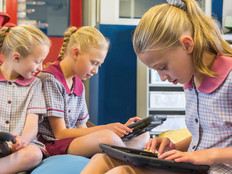2007 New Year’s Resolutions For K12 Classrooms
This school year, I resolve NOT to…
- Sweat the small stuff, particularly when dealing with emerging technology users. — Nebraska
- Let technology decisions drive instructional decisions. — Colorado
- Do anything but support my group and make them successful. — Maryland
- Push technology down people’s throats (since I am such a tech advocate). — Massachusetts
- Lose my temper. — Arizona
- Make arbitrary decisions without appropriate input from principals. — Texas
- Go in 10 separate directions at once. — Texas
- Allow the needs of adults to drive our educational system. — Wyoming
- Cave in too much to politics of district operations and, instead, do what my heart tells me I should be doing. — New Jersey
- Forget to schedule uninterrupted time for reflection and planning. — Colorado
Hold The Phone
The next time you’re tempted to throw a pupil’s cell phone out the window, consider this: You might be interrupting her Chinese language class.
Course instruction via mobile phone has been identified by Educause of Boulder, Colo., and New Media Consortium of Austin, Texas — educational technology advocacy groups — as an up-and-coming classroom must-have. In their report, Horizons 2006, the technology advocacy groups predict that while the use of cell phones to deliver educational material is still in its infancy, it is destined for rapid growth. “Its value to education will become apparent when we are able to use it to deliver educational content — right to the phones in their pockets,” states the report.
The report predicts it will be two to three years before “m-learning,” as advocates like to call it, hits higher education. How soon before cell phone classes trickle down to K−12? While there have been numerous K–12 deployments of personal digital assistants and even some test projects using so-called “smart phones,” such as Palm’s Treo, few educators are eager to make the classroom-mobile phone connection.
Cell-phone-based language lessons have been tried at the Stanford Learning Lab, Rice University and elsewhere, but they have yet to catch on. As for the Chinese language instruction, that’s available via mobile phone from a service called 12wap, offered by Clearhub of Singapore (www.clearhub.com).






